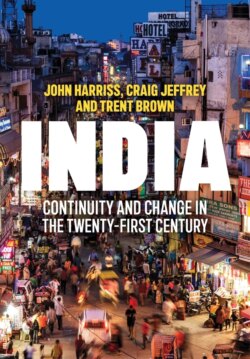Читать книгу India - Craig Jeffrey - Страница 29
3 How ‘Inclusive’ is India’s Economic Growth? 3.1 Introduction: Economic Growth and ‘Development’
ОглавлениеEconomic growth is not synonymous with ‘development’ – if, by the latter, we understand the improvement of well-being throughout society. We follow the great Indian economist, Amartya Sen, in believing that development should be understood as being about expanding the real freedoms of people to lead lives that they have reason to value (Sen 1999). This means, in Sen’s terms, thinking about development in terms of ‘capabilities’ – people’s abilities to do things, and to live lives that they value – rather than in terms of ‘commodities’. This does not mean that commodities – both goods and services – are of no account at all. Clearly not, for if people have insufficient means to secure adequate nutrition, clothing, shelter and the services that they need in order to lead a worthwhile life, then the objectives of development cannot be achieved. Material poverty matters hugely, and economic growth – which involves expanding the supply of commodities – does matter. A critical question, however, is that of whether, or how far, growth serves to reduce material poverty, and to increase opportunities for people to realize the end of leading lives that they have reason to value. In this chapter we are concerned with the question of how well India is doing in regard to these objectives. We are especially concerned with the extent to which continuing low levels of education and health – human capital, in economists’ language – have limited opportunities for a majority of India’s people.
The way in which growth is achieved matters a great deal. Clearly, if the benefits of growth accrue mostly to a small fraction of the population, then development objectives may not be realized for the majority. An important question is that of how far increasing material inequality is consistent with the realization of development goals. Former British prime minister, Tony Blair, once argued that increasing inequality in the country didn’t matter, because it was like a rising tide, with increasing wealth ‘lifting all boats’. But increasing inequality may mean that opportunities for lifting their boats (to extend the metaphor) are denied to some, or that they lift their boats much less than they might have been able to. Do people benefit from growth because they are active participants in the growth process, or do they benefit only by ‘trickle down’ from the wealth of the few? Does the growth process increase opportunities for people to lead lives they have reason to value?
Recognizing the importance of these questions, Governments of India have made commitments to the goal of ‘inclusive growth’. This was the theme of India’s Eleventh Five Year Plan, for the period 2007–12, and the title of the first main volume of the Plan document. It was said that:
The central vision of the Eleventh Plan is to build on our strengths to trigger a development process which ensures broad-based improvement in the quality of life of the people, especially the poor, SCs/STs, other backward castes (OBCs), minorities and women’ (Planning Commission 2008: 2)
The list of those whose quality of life is to be improved, according to this statement – and a comparable one in the Twelfth Five Year Plan, which repeated the objective of bringing about inclusive growth (Planning Commission 2013: vi) – is a long one, accounting for all but a fairly small minority of the population of the country. According to the Census of 2011, the Scheduled Castes (SCs) accounted for 16.6 per cent of the population, and the Scheduled Tribes (STs) for a further 8.6 per cent. Add to this quarter of the population the numbers of those officially designated as members of the ‘Other Backward Classes’ (OBCs – according to the official definition, ‘backward classes’, not ‘castes’), who are estimated to make up around 40 per cent of the population (according to National Sample Survey estimates, reported in Times of India, 1 September 2007), and we have two-thirds of the population of India. To this should be added, in the light of accumulating evidence about their disadvantage in many spheres of life, most of the Muslims (the most significant ‘minority’) who made up 14.2 per cent of the population in 2011. Even if we take no separate account of women, the Plan document clearly refers to a large majority of the people in the country.
In this chapter we take up the question of how far the ‘vision’ of improving the quality of life of the majority has been realized. First, having considered the problems that surround the construction and measurement of poverty, we present evidence showing that while progress has been made in regard to the alleviation of poverty – variously understood – in the aggregate, the rate at which it has been reduced has probably been lower than might have been expected, or in comparison with other South Asian countries (notably Bangladesh), at least in part because of increasing inequality. But for us, the most telling criticism of India’s performance, in regard to the well-being of Indians, is that it remains the case that a very large proportion of the population is still vulnerable to falling into poverty, even after years of high rates of economic growth. We also show that the relative exclusion of the groups referred to specifically in the Plan documents has continued. In practice the benefits of growth in India continue to be very unequally distributed, and social divisions, of gender, caste and religion have in many ways become more profound. We reflect upon these trends, and the evidence from rich empirical studies of the severe constraints upon social and economic mobility in India. We go on, in the next chapter, to discuss what limits the achievement of development goals in India today.
